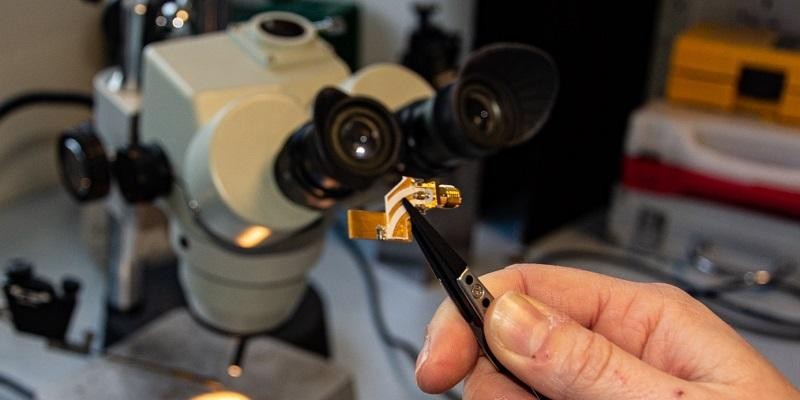Feb 12 2020
Scientists have developed a new approach to control terahertz quantum cascade lasers. This major breakthrough can help transmit data at the speed of 100 GB/second.
 The image shows the quantum cascade laser, on its mounting, being held by a set of tweezers. Image Credit: University of Leeds.
The image shows the quantum cascade laser, on its mounting, being held by a set of tweezers. Image Credit: University of Leeds.
Transferring data at ultra-fast speed would be about one thousand times speedier than a fast Ethernet working at 100 Mbit a second.
Terahertz quantum cascade lasers produce light in the terahertz range of the electromagnetic spectrum. This feature sets them apart from other types of lasers. Terahertz quantum cascade lasers can be used in the field of spectroscopy where they are applied to chemical analysis.
Ultimately, these lasers may also offer ultra-fast, short-hop wireless links in which huge datasets have to be transmitted between research facilities on universities or across hospital campuses, or even in satellite communications.
However, to send data at these increased speeds, the lasers had to be modulated very quickly, that is, turning on and off or pulsing approximately 100 billion times per second.
So far, researchers and engineers have not developed a way to achieve this.
Now, a research team of academics from the University of Nottingham and the University of Leeds believes that it has identified a new method to deliver ultra-fast modulation, by integrating the power of light and acoustic waves. The results were recently published in the Nature Communications journal.
This is exciting research. At the moment, the system for modulating a quantum cascade laser is electrically driven—but that system has limitations. Ironically, the same electronics that delivers the modulation usually puts a brake on the speed of the modulation. The mechanism we are developing relies instead on acoustic waves.
John Cunningham, Professor of Nanoelectronics, School of Electronic and Electrical Engineering, University of Leeds
A quantum cascade laser is known to be highly efficient. When a single electron travels via the laser’s optical component, it goes through a range of “quantum wells” in which the electron’s energy level reduces and a pulse of light energy, or photon, is produced.
A single electron has the ability to produce multiple photons. This process is the one that is regulated at the time of modulation.
But the scientists used acoustic waves instead of external electronics to vibrate the quantum wells within the quantum cascade laser. When a pulse from another laser falls onto an aluminum film, the impact produces acoustic waves. This causes the aluminum film to contract and expand, delivering a mechanical wave via the quantum cascade laser.
Essentially, what we did was use the acoustic wave to shake the intricate electronic states inside the quantum cascade laser. We could then see that its terahertz light output was being altered by the acoustic wave.
Tony Kent, Professor of Physics, University of Nottingham
Professor Cunningham added, “We did not reach a situation where we could stop and start the flow completely, but we were able to control the light output by a few percent, which is a great start. We believe that with further refinement, we will be able to develop a new mechanism for complete control of the photon emissions from the laser, and perhaps even integrate structures generating sound with the terahertz laser, so that no external sound source is needed.”
This result opens a new area for physics and engineering to come together in the exploration of the interaction of terahertz sound and light waves, which could have real technological applications.
Tony Kent, Professor of Physics, University of Nottingham
The research was financed by the Engineering and Physical Sciences Research Council.